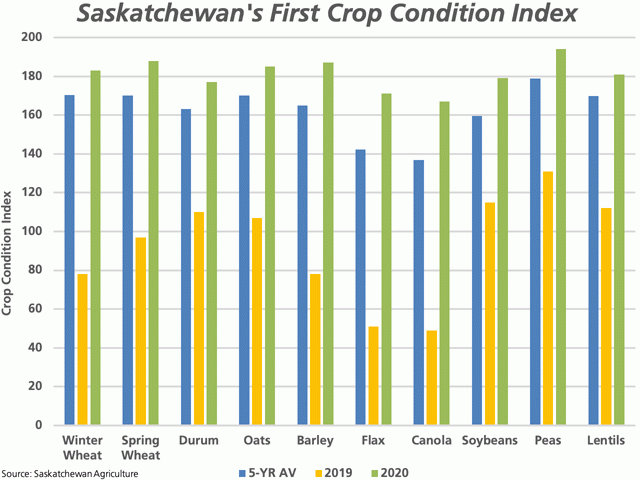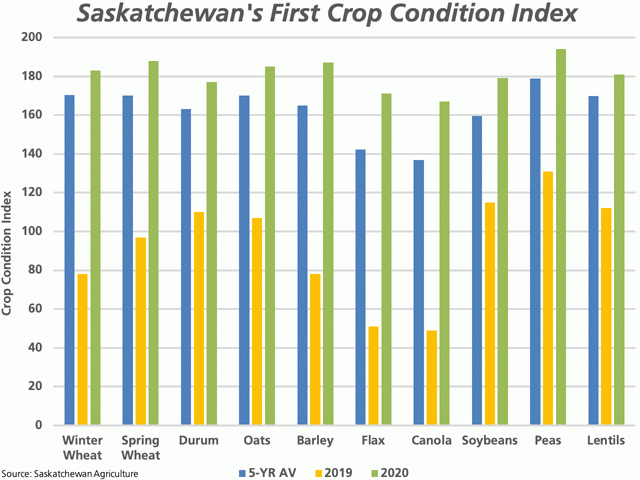Canada Markets
Saskatchewan's Initial Crop Condition Estimates
Saskatchewan Agriculture's first crop condition ratings released for the 2020 growing season show crops off to a good start, with spring planting nearing an end and a potential significant rain event in the forecast.
As of June 1, an estimated 96% of the province's crop was reported as seeded, which compares to 99% last year, the five-year average of 92% and the 10-year average of 83% complete. Looking at past data, the pace of planting of lentils, peas and soybeans are roughly at their four-year average pace, while seeding of spring cereals and canola is well ahead of the average pace over the past four years.
Of the selected crops on the attached chart, the good-to-excellent rating for crops reported as of June 1 ranged from 69% for canola to 84% for peas. In all cases, except for oats and dry peas, the good-to-excellent rating as of June 1 is more than two times the rating reported for the same week in 2019.
P[L1] D[0x0] M[300x250] OOP[F] ADUNIT[] T[]
The attached chart shows the crop condition index (CCI) for the selected crops, based on the formula:
CCI = (% Excellent * 3) + (% Good * 2) + (% Fair * 1) + (% Poor * -1) + (% Very Poor * -2)
This allows for easy comparison of data from year to year.
Of the selected crops, this index ranges from 167 for canola to 194 for dry peas, as indicated by the green bars. In all cases, the current CCI is well above the levels calculated for 2019 (brown bars) as well as above the respective five-year average (blue bars). When the past five years are considered, the indices calculated for June 1 are the highest seen in three years, (except for winter wheat, which is the highest in two years). Over the past five years (2015-19), the indices calculated for the first release of crop conditions were higher than the current indices in both 2016 and 2017, while lower in 2015, 2018 and 2019. If the average of these indices were compared over these years, the 2017 average is 5.3% higher than the current average, while the 2016 average is 18.4% higher.
Despite what seems to be favorable estimates of crop condition, the province shows caution in its overall assessment, describing the majority of crops as good, while the smaller-seeded crops such as mustard and canola are described as fair to good, with a combination of dry conditions, wind and flea beetles causing damage.
As of June 1, the province's topsoil moisture assessment shows the poorest conditions seen so far in the five weeks of this season, with 34% of the cropland rated at short-to-very-short topsoil moisture. Three weeks ago this was reported at a low of 11%. This compares to a 78% short-to-very-short rating shown one year ago, while a significant rain event is expected over the June 6-7 weekend and continuing into the following week.
Cliff Jamieson can be reached at cliff.jamieson@dtn.com
Follow him on Twitter @Cliff Jamieson
© (c) Copyright 2020 DTN, LLC. All rights reserved.






Comments
To comment, please Log In or Join our Community .